Course Details
We all want to do everything we can to make our next performance dog be the very best she can be. This means not just being a good trainer, but making good decisions about where our dogs come from, based on a solid understanding of how genetics and environment interact to affect the developing dog. In this course, you will get your science on! We will learn about developing brains, the importance of very early socialization, and we will grapple with the "to neuter or not to neuter" question, all based on recent scientific articles.
Jessica is a veterinarian who decided that she was more interested in learning how things go wrong with dogs than in how to fix them, so she went back to school (again) to get a Ph.D. in the genetics of dog behavior. She is actively engaged in research on how genetics affect the development of different personalities in dogs. She also has a lot of experience in teaching dog trainers and loves getting into geeky conversations with students about the biology of dogs. Having recently gotten a new performance dog and being hip-deep in training him for agility, parkour, and nosework, she also has an understanding of the unique perspective of the sports enthusiast who wants both a pet and a teammate.
This course is not about teaching your dog specific behaviors. It is about learning some cool science, asking questions, and talking through the answers. For some, it will be about learning how to think scientifically. For others, it will be about diving right in to the latest dog research. If you think dog science is awesome, this is the class for you.
CCPDT: 6 hours CEU for behavior consultants.
Syllabus
WEEK ONE: Breeds, sport crosses, and mutts: pros and cons
WEEK TWO:
A What is anxiety at a biological level?
B How do the dam's mothering skills affect the puppy's adult personality?
WEEK THREE: How does brain wiring change during the socialization period?
WEEK FOUR: The onset of fear behavior in puppies, and how it differs across breeds
WEEK FIVE: To neuter or not to neuter: what does the science say?
WEEK SIX: To neuter or not to neuter: societal issues; and class wrap-up
Prerequisites & Supplies
There are no prerequisites for this class. The class will support students of all levels of science background, providing both basic information for those who want it, and geeky details for those who want that.
Sample Lecture
The History of Intentionally Breeding Mixed-Breed Dogs
When I did agility with my first dog, back in 2005, the hot sport-bred mix was the borderjack (Border collie/Parsons Russell terrier). I left agility for veterinary school, and didn't return until 2017 with my new sport puppy. Suddenly there were so many new sport mixes! (Maybe there always were and I didn't know about them until Facebook brought us all closer together.) I have never owned an intentionally-bred mixed breed dog, and I am new to the world of sport-bred mixes, so if any of you have strong ties to this community, I'd love to learn more.
Intentionally breeding mixed-breed dogs, sometimes referred to as "designer dogs," started with breeding poodle mixes. These dogs were initially bred to provide low-allergen dogs to the guide and asssistance dog communities, but quickly spread to the pet population. New intentional mixes continue to appear today.
Borderjacks were the first sport mixes that I encountered, as I said. I can't speak to the motivations of the people who bred them, but I imagine getting a dog with some border collie traits but in a smaller package for flyball was one motivator. In my experience, border collie mixes continue to predominate in the sport mix world: border staffies, border whippets, and border paps. Mixes with Staffordshire bull terriers also seem to be common currently. (Of course, many 50/50 dogs of unintentional breeding also end up doing quite well in sports!)
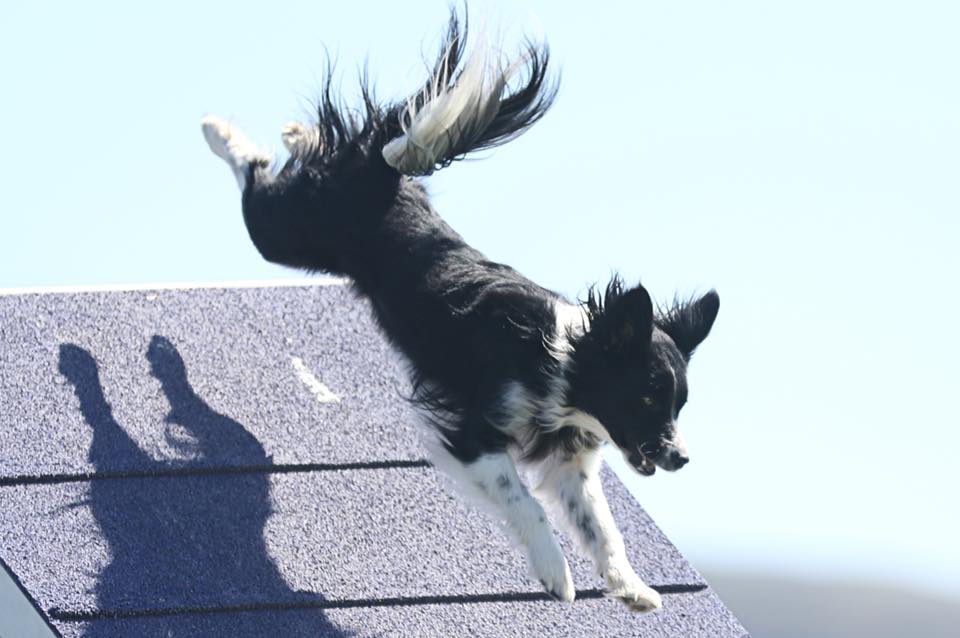 |
Honey Nut Cheerio, owned by Jean Muenster. Papillon/border collie (border pap). USDAA Masters Gamblers, Advanced Agility Dog. |
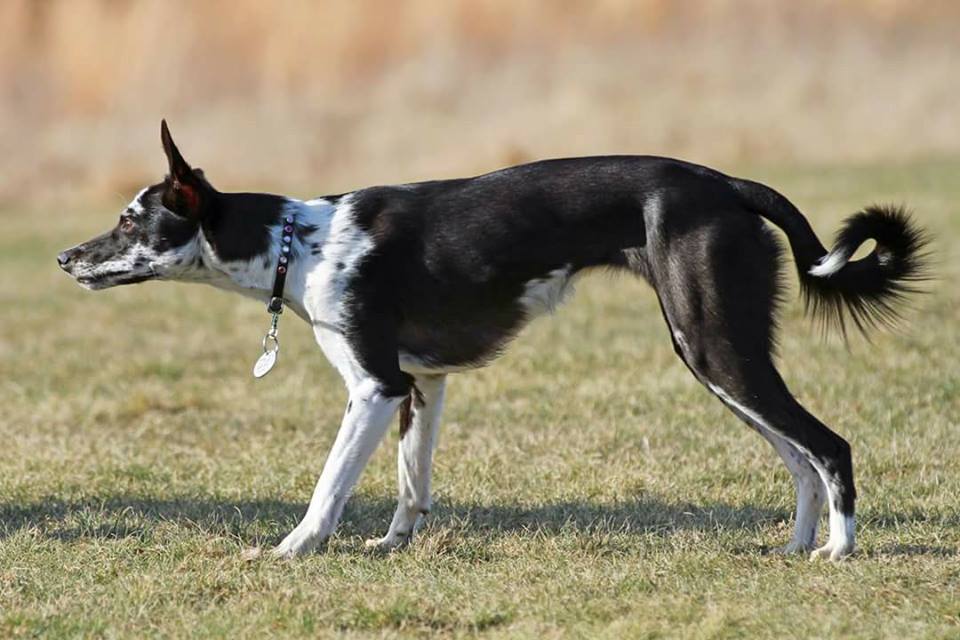 |
Oswin, owned by Tena Parker. Border collie/whippet (border whippet or bippet). Competes in agility, coursing, and disc; titled in rally-o and trick dog. |
 |
Wixer, owned by Susan Cleveland. Border collie/Staffordshire Bull terrier (border staffy). Flyball (FM, TFE-II), barn hunt (RatchX), agility, HRD Search Dog in training. |
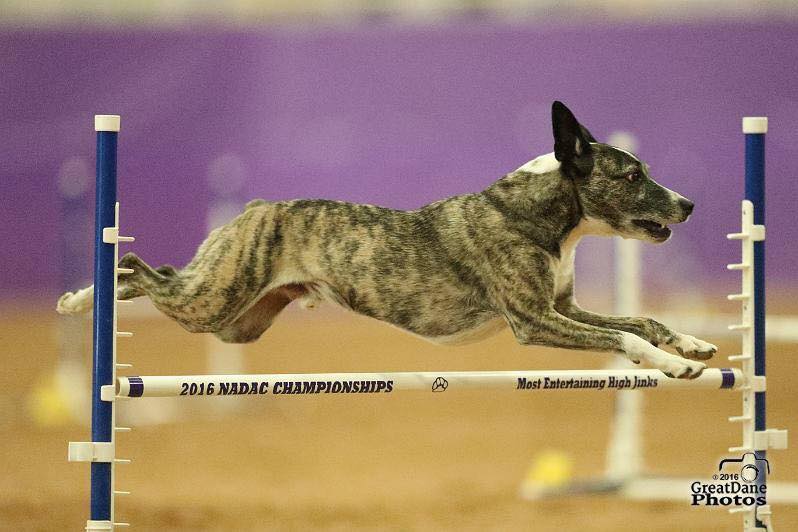 |
Tohrment, owned by Kimberley Olsen. Border collie/Staffordshire Bull Terrier (border staffy). Flyball, agility, dock diving, frisbee, barn hunt. Titles in multiple sports. |
Health
Do you increase your chances of getting a healthy dog by getting a sport-bred mix, compared to getting a purebred? I wish some study even took a shot at answering this question!
On the one hand, mixes are by definition less inbred than purebred dogs. For many diseases, this will dramatically reduce the chance that the dog will get the disease. Specifically, if a disease requires that a dog be homozygous for the disease (have inherited the risk for the disease from both mom and dad), then having one parent be from a breed with a low incidence of that disease will greatly reduce your chance of the dog getting it.
On the other hand, if both breeds are at high risk for a particular disease, it's not clear if crossing them reduces the risk for that disease. This really depends on the genetics of that disease. For many diseases, there are a bunch of different genes that can carry mutations for a particular disease. Cancer and hip dysplasia are both great examples of this - they have many genes interacting to increase risk of both of these diseases.
So in breed A, one particular gene may be broken in every dog in the breed, causing an increased risk of cancer in that breed. If a puppy's parents are both from breed A, the puppy will get two versions of that broken gene, and be at higher risk of getting that particular form of cancer. Now we consider crossing mom from breed A with dad from breed B. Breed B also has a high risk of this particular type of cancer. But the big question is whether the same gene is at fault. If so, crossing mom from breed A with dad from breed B won't help reduce your risk of cancer - the puppy will still have two copies of that one broken gene. But if breed B has a different gene at fault, then crossing those two breeds may in fact mean that the puppy has at least one good (working) version of each of the problem genes, and therefore does not have a higher risk of cancer.
How can you know, for your particular pair of breeds, and the particular disease you're worried about? Researchers are working hard on pinning down the mutations involved in particular diseases right now, but so far, the number of genetic tests in dogs that have actually found the gene and mutation involved is pretty small. Mostly, genetic tests have found markers that are close to (but not necessarily in) genes, and often these tests have only been studied in a few breeds. We're still very much in unknown territory here.
When trying to assess disease risk, it's a good policy to avoid mixing two breeds that have similar health issues without testing the parents for that disease. Alternatively, read up on the studies about those health issues and see what is known about the genetics of them. How similar are the genetics across breeds? Have they even been assessed? For many cases the answer will be "no," and then you should play the "better safe than sorry" game - but for some cases, breed-specific issues may be well understood. Perhaps the best way to assess this is to look at other dogs from this particular cross and see how often they have this disease.
Predictability
Purebreds are generally predictable (although all dogs are individuals and there is quite a bit of variation within a breed). Intentionally-bred mixes can still be fairly predictable, with some caveats.
The first generation of a mix - where both parents are purebreds - is the "F1" generation. This generation produces highly predictable puppies. Goldendoodles are quite recognizable as goldendoodles - we can pick them out just as we can members of a breed, whereas it is notoriously difficult to assess the ancestry of a truly mixed-breed ("random-bred") dog. This is because, when mom and dad get together to hand off genes to their offspring, the baby inherits one copy of a gene from mom and one from dad. But parents who are purebreds have identical copies of both pairs of genes (identical alleles) - it doesn't matter which copy they give to the puppy, because both are the same. So if you cross a golden and a poodle, you know that the golden will give an allele for straight hair (because all goldens have two copies of the allele for straight hair) and the poodle will give an allele for curly hair (because all poodles will have two copies of the allele for curly hair). This means that the goldendoodle puppies will always have one allele for straight hair and one for curly hair - always! Which gives goldendoodles their distinctive wavy coats. (See Lecture 1a for more details on alleles and predictability.)
We can predict what a goldendoodle's coat will look like because we're familiar with that cross. However, the first person to cross a golden and a doodle didn't know how those different alleles would interact. If predictability is important to you, go with a well-understood cross that has been used successfully in the sport world before, rather than a new experiment.
While F1s, like goldendoodles, are relatively predictable in type, with the next generation (F2), things change. This is because, while a purebred dog has identical alleles of all the genes that matter for his type (he is homozygous), the F1 cross has one allele from one breed and one from the other breed (he is heterozygous). When you breed a purebred, you know what allele he or she will give the puppy for a particular trait, because both alleles are the same. When you breed an F1, however, you don't know what allele he or she will give - the one from the golden, or the one from the poodle?
F2s may be crosses of two F1s - breeding a goldendoodle to a goldendoodle. For a bit more predictability, they may also be backcrosses to purebreds. For example, if you wanted a little more Parsons Russell in your borderjack, you might breed a borderjack back to a purebred Parsons Russell. You'd get something fairly terrier-ish, but with an unpredictable amount of BC in it. Here's an example of three littermates from exactly this breeding. Note the differences in head shape and coat length and texture.
 |
Fizz (Nseine's Never Going To Fizzle Out), owned by Savannah Elias; FD and FDX (flyball) at 18 months; training in agility, dock diving barn hunt, and disc. |
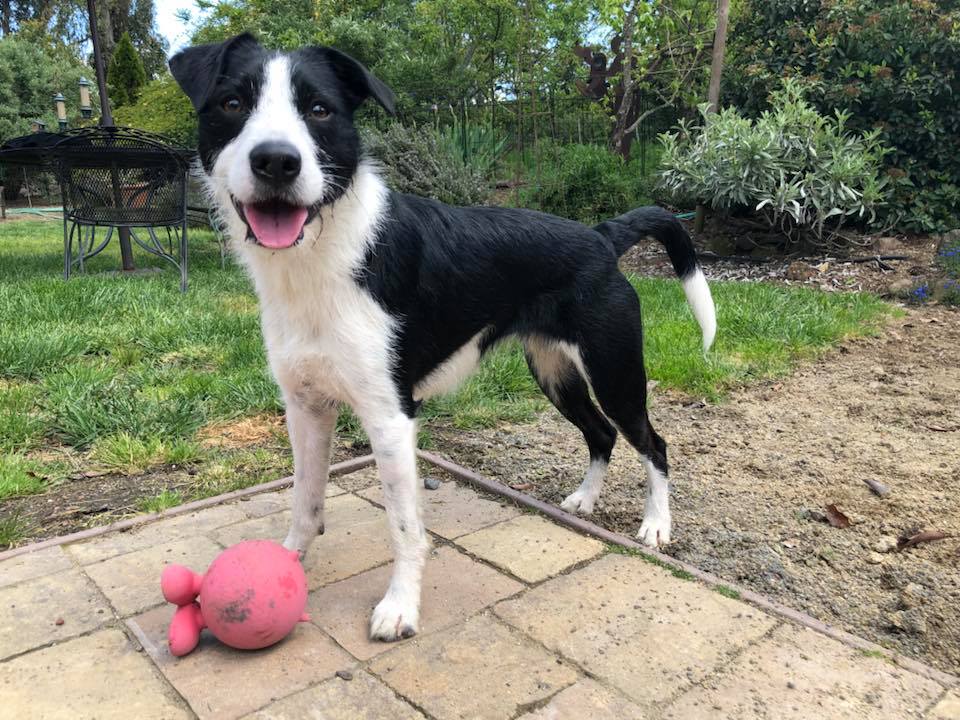 |
Littermate Spec, owned by Aryn Hervel. |
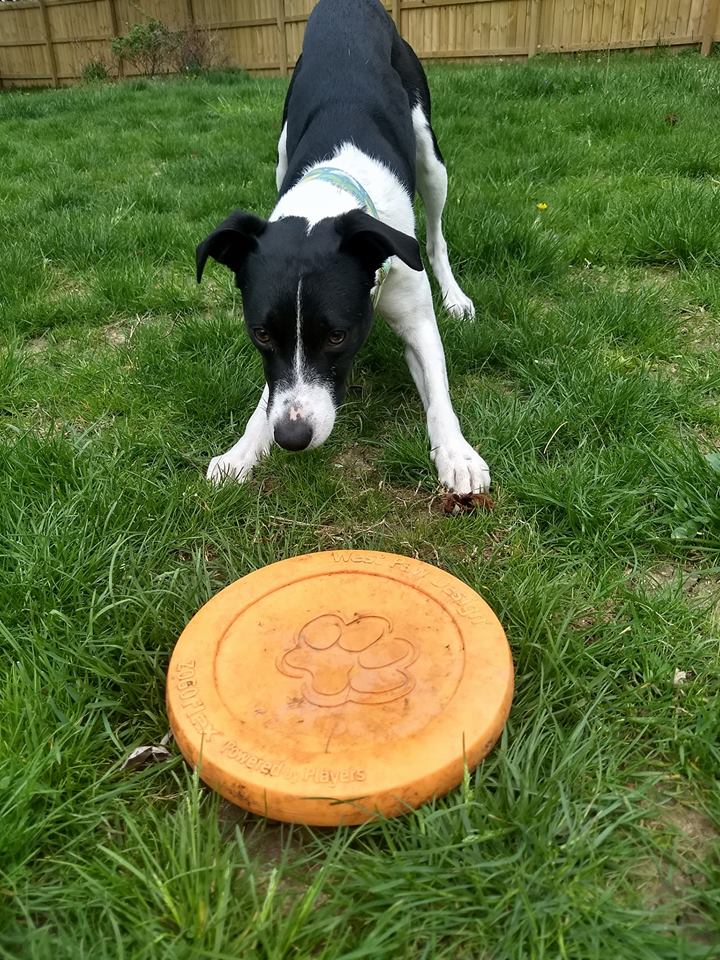 |
Littermate Flux. owned by Abigail Curtis. |
Borderjacks are an interesting example as well because both border collies and Parsons Russell terriers are relatively outbred breeds, having been brought into the AKC relatively recently. Both breeds have a greater variety of color, shape, and coat type in them than some other breeds, such as labrador retrievers. This means that fewer genes have fixed alleles in these breeds, and as a result their crosses are a bit less predictable.
Inbreeding in Intentionally Bred Mixes
I was surprised the first time I encountered line breeding in a sport-bred mix, but people do breed relatives to each other in this community, as a way of increasing the predictability of the desirable sporty traits. Again, this is a tradeoff - predictability of traits is good, but it comes with an increased risk of genetic disease. If you're looking at a sport-bred mix to get a more outbred dog, be sure to talk to the breeder about line breeding; don't just assume that the dog is completely outbred because it's a sporty cross.
The Social Aspect
Breeding dogs of different breeds is looked down upon in some parts of the dog world. Some sport breeders report that they have difficulty obtaining high quality breeding stock from purebred breeders for the purpose of making crosses. In the pet world, designer crosses with cute nicknames for the cross are used as a marketing tactic by breeders who produce too many dogs and dogs of low quality, and are also often found in straight up puppy mills. This throws a shadow over the entire approach to breeding dogs in the minds of some. Others feel that only purebreds should be intentionally bred, and mixes should only be acquired from shelter/rescue.
Personally, I feel that being a reputable breeder of behaviorally and medically healthy dogs is not directly related to whether your dogs are purebred or mixes. But it is worth remembering, when choosing to get an intentionally bred mix, that you may encounter disapproval from some for your choice.
Conclusions
The predictability-versus-health tradeoff exists in the cross-bred world just as in the purebred world. However, F1 crosses may represent a sweet spot: two purebred parents result in a highly predictable phenotype, very likely associated with a reduced risk of genetically-mediated disease. For more predictability, look for a well-known cross rather than an experiment. And just as in finding a breeder of purebred dogs, do your research on your breeder - crossing isn't a magic bullet and still requires know-how to do right.
Discussion Questions
(My suggestions to get you started talking on the forum - but feel free to ask your own questions instead.)
Is a sport cross for you? What breeds? How confident are you that you woud get the characteristics you're looking for (compared to going with a purebred)?
Testimonials & Reviews
A sampling of what prior students have said about this course ...
Jessica has a passion for her subject of biology and how that impacts our working dogs, and it shows. I got a lot of exposure to current research and where there is more to do, and it definitely helps with my decisions on what to do with my dogs. This class should be taken by anybody who raises puppies for sports - it's that important!
Dr. Hekman, I found this class very interesting and relevant, especially since I work in the breeding depatment of an assistance dog school. I found some ideas that I can share with the volunteers working on socialization with our very young puppies to help them reach their true potential. Thank you!
Fascinating class and discussions wer so respectful even when dealing with some contentious topics. Tone of class was perfect. Lots of material, not overwhelming although I suspect almost every topic could have been the subject of a 6 week class that is definitely take. Hope it’s offered again so I can take at silver and hope more classes are offered.
Jessica does an amazing job of presenting very technical information in an understandable way. I also really appreciate that she is honest about where science hasn’t caught up. She is also great about dissecting the causality (or lack there of) in studies and stuff to help us really appreciate the nuances of current understanding. As long as I have time to squeeze in a class, another one of these would be top on my list. Science geeks rock! :D
Jessica: what a pleasure! I learned so much through your lectures, your responses to the students, and from the students themselves. It was an incredibly engaging, thoughtful, interesting class, and you were a great teacher. I found myself having little epiphanies throughout. Cat Warren
IMO this class is a MUST for anyone who is interested in behavior and training ... or breeding! It’s an element I’ve seen little written on to date. It’s an eye opener. I look forward to more related classes on the biology and genetics of behavior.
Registration
There are no scheduled sessions for this class at this time. We update our schedule frequently, so please subscribe to our mailing list for notifications.
BH510 Subscriptions
 Silver |
 Bronze |
|
|---|---|---|
| Tuition | $ 130.00 | $ 65.00 |
| Enrollment Limits | 20 | Unlimited |
| Access all course lectures and materials | ✔ | ✔ |
| Access to discussion and homework forums | ✔ | ✔ |
| Read all posted questions and answers | ✔ | ✔ |
| Watch all posted videos | ✔ | ✔ |
| Post general questions to Discussion forum | ✔ | ✖ |
| Post dog specific questions | With video only | ✖ |
| Post videos | Up to 2 | ✖ |
| Receive instructor feedback on |
|
✖ |
Find more details, refund policies and answers to common questions in the Help center.